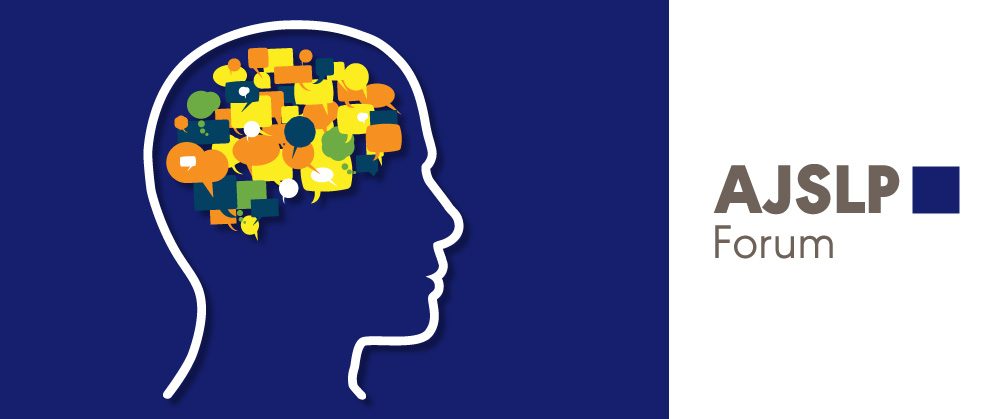Like most things planned in 2020, the 50th Clinical Aphasiology Conference (CAC) was canceled due to COVID-19. However, the authors who planned to present their findings at the conference are now showcasing their discoveries via a forum in the American Journal of Speech-Language Pathology (AJSLP).
Guest Editor Melissa Collins Duff has worked diligently to present nine articles in the latest issue of AJSLP. These articles represent the intersection of basic and clinical research in aphasia and mild traumatic brain injury (mTBI). Duff has identified three particular themes in this forum, highlighted below.
Characterizing and Managing Aphasia
Four articles contribute to our current knowledge of aphasia and provide practical advice for clinicians. After Duff’s introduction to the forum, Fama and colleagues analyze interview data from 53 people with poststroke aphasia on their subjective experiences with anomia, or difficulty with naming and word-finding. Then, Obermeyer and colleagues look at the effects of two variables—category typicality and working memory load—on semantic processing in aphasia.
The next article by Stark and Cofoid looks at the role of gesturing during discourse in aphasia, pointing to a need to understand how and when people with aphasia use spontaneous gestures. In the last of these four articles, Tabrizi and colleagues return to the topic of anomia, looking at repetition priming as a treatment paradigm for patients.
Discourse in Mild TBI
The next two articles focus on advances in the study of discourse in mTBI. Each year, the United States sees 1.6 million new cases of mTBI (Myers et al., 2022, p. 84). The articles below highlight the importance of studying how these individuals communicate.
First, Norman and colleagues compare the way in which adults with mTBI perform on a standard elicitation task, comparing it to the performance of healthy adults, those with orthopedic injuries, and adults with moderate to severe TBI. Then, Myers et al. show that posttraumatic stress disorder (PTSD) can contribute to verbal deficits in adults with mTBI.
New Directions
Finally, the last three articles look at innovation and new directions in the treatment of aphasia. Kinsey et al. look at a very modern question: How do people with aphasia text? Although the results were variable, the authors stress the importance of examining each aphasia patient’s unique texting abilities.
The final two articles look at novel treatment approaches for aphasia. Sherrill and Hengst (2022) found that animal-assisted therapy sessions created “meaningful, rich, and complex communicative environments” (p. 113) where people with aphasia could talk with others about shared interests. In the last article of the forum, Bislick and colleagues looked at the benefits of yoga on two individuals post-stroke.
More on CAC
This is our 10th year publishing papers from the CAC! You can read highlights from the last 5 years on Context, and you find even more in the AJSLP archives.
We’d like to thank Dr. Duff for serving in her second straight year as a guest editor for articles showcasing emerging research from the CAC, and we thank all of the authors who contributed to this AJSLP forum.We hope that you enjoy this collection of articles on the latest research in aphasia and other neurologic language disorders.
References
Myers, J. R., Solomon, N. P., Lange, R. T., French, L. M., Lippa, S. M., Brickell, T. A., Staines, S., Nelson, J., Brungart, D. S., & Coelho, C. A. (2022). Analysis of discourse production to assess cognitive communication deficits following mild traumatic brain injury with and without posttraumatic stress. American Journal of Speech-Language Pathology, 31(1), 84–98. https://doi.org/10.1044/2021_AJSLP-20-00281
Sherrill, M., & Hengst, J. A. (2022). Exploring animal-assisted therapy for creating rich communicative environments and targeting communication goals in subacute rehabilitation. American Journal of Speech-Language Pathology, 31(1), 113–132. https://doi.org/10.1044/2021_AJSLP-20-00284
Explore the Forum
Bislick, L., Dietz, A., Duncan, E. S., Garza, P., Gleason, R., Harley, D., Kersey, G., Kersey, T., Mamlekar, C. R., McCarthy, M. J., Noe, V., Rushlow, D., Rushlow, J. C., & Van Allan, S. (2022). Finding “zen” in aphasia: The benefits of yoga as described by key stakeholders. American Journal of Speech-Language Pathology, 31(1), 133–147. https://doi.org/10.1044/2021_AJSLP-20-00330
Duff, M. C. (2022). Introduction to the 2020 Clinical Aphasiology Conference forum. American Journal of Speech-Language Pathology, 31(1), 1–2. https://doi.org/10.1044/2021_AJSLP-21-00370
Fama, M. E., Lemonds, E., & Levinson, G. (2022). The subjective experience of word-finding difficulties in people with aphasia: A thematic analysis of interview data. American Journal of Speech-Language Pathology, 31(1), 3–11. https://doi.org/10.1044/2021_AJSLP-20-00265
Kinsey, L. E., Lee, J. B., Larkin, E. M., & Cherney, L. R. (2022). Texting behaviors of individuals with chronic aphasia: A descriptive study. American Journal of Speech-Language Pathology, 31(1), 99–112. https://doi.org/10.1044/2021_AJSLP-20-00287
Myers, J. R., Solomon, N. P., Lange, R. T., French, L. M., Lippa, S. M., Brickell, T. A., Staines, S., Nelson, J., Brungart, D. S., & Coelho, C. A. (2022). Analysis of discourse production to assess cognitive communication deficits following mild traumatic brain injury with and without posttraumatic stress. American Journal of Speech-Language Pathology, 31(1), 84–98. https://doi.org/10.1044/2021_AJSLP-20-00281
Norman, R. S., Mueller, K. D., Huerta, P., Shah, M. N., Turkstra, L. S., & Power, E. (2022). Discourse performance in adults with mild traumatic brain injury, orthopedic injuries, and moderate to severe traumatic brain injury, and healthy controls. American Journal of Speech-Language Pathology, 31(1), 67–83. https://doi.org/10.1044/2021_AJSLP-20-00299
Obermeyer, J., Reinert, L., Kamen, R., Pritchard, D., Park, H., & Martin, N. (2022). Effect of working memory load and typicality on semantic processing in aphasia. American Journal of Speech-Language Pathology, 31(1), 12–29. https://doi.org/10.1044/2021_AJSLP-20-00283
Sherrill, M., & Hengst, J. A. (2022). Exploring animal-assisted therapy for creating rich communicative environments and targeting communication goals in subacute rehabilitation. American Journal of Speech-Language Pathology, 31(1), 113–132. https://doi.org/10.1044/2021_AJSLP-20-00284
Stark, B. C., & Cofoid, C. (2022). Task-specific iconic gesturing during spoken discourse in aphasia. American Journal of Speech-Language Pathology, 31(1), 30–47. https://doi.org/10.1044/2021_AJSLP-20-00271
Tabrizi, R., Walton, L., Simon, E., & Silkes, J. P. (2022). Repetition priming in treatment of anomia. American Journal of Speech-Language Pathology, 31(1), 48–66. https://doi.org/10.1044/2021_AJSLP-20-00278







